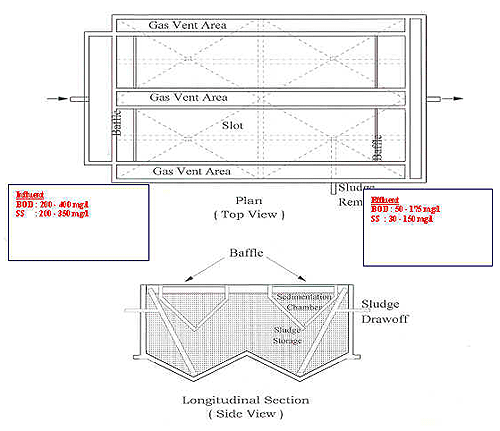-
 Sewerage Facts
Sewage • Sewage Characteristics • Sewage Treatment Objectives • Sewage Treatment Methods • Sewage Treatment System • The Evolution Of Sewage Treatment Sewage Treatment Plant • Package Plants • Combined Process • Imhoff Tanks • Oxidation Pond Effluent Standards Individual Septic Tanks Population Equivalents Water Cycle Confined Space Ammonia Green Technology Lighter Side
Sewerage Facts
Sewage • Sewage Characteristics • Sewage Treatment Objectives • Sewage Treatment Methods • Sewage Treatment System • The Evolution Of Sewage Treatment Sewage Treatment Plant • Package Plants • Combined Process • Imhoff Tanks • Oxidation Pond Effluent Standards Individual Septic Tanks Population Equivalents Water Cycle Confined Space Ammonia Green Technology Lighter Side - Technical Resources Center
-
 INDAH WATER RESEARCH CENTRE
INDAH WATER RESEARCH CENTRE
 Imhoff Tanks are simple form of sewage treatment plants requiring very little operator skill. There is no mechanical equipment to maintain and operation consists of removing scum, reversing the flow to keep an even distribution of sludge and removing sludge.
Imhoff Tanks are simple form of sewage treatment plants requiring very little operator skill. There is no mechanical equipment to maintain and operation consists of removing scum, reversing the flow to keep an even distribution of sludge and removing sludge.
Imhoff tanks constitute 24 per cent (800 numbers) of all sewage treatment plants in Malaysia and are the second most common form of treatment plant. They provide limited treatment of sewage and are not a suitable long-term solution. The effluent from Imhoff tanks can rapidly deteriorate if the tanks are not properly maintained.
An IT comprises two chambers positioned one above the other. In the upper compartment sedimentation occurs with solids passing through an opening into the lower chamber. Settled solids form sludge in the lower chamber and undergo anaerobic digestion. Gases from the lower tanks are discharged to the air. Scum is accumulated in the upper tank.
Sewage from the connected premises enters the sedimentation tank where settlement of solids occurs. Heavier solids settle at the bottom of the tank as sludge. Liquid effluent from the sedimentation tank then trickles through a rock filter bed. The sedimentation tank needs to be desludged regularly. Organisms living in the rock filter feed on the sewage, treating it in the process. Treated effluent is collected and discharged into a nearby drain. Usually, the sedimentation process in the upper chamber is followed by percolating effluent over a coarse stone media before discharge to a receiving water.
ITs are normally used to service small communities up to a population equivalent (PE) of 1,000. They are relatively cheap to install, operate and maintain. However, ITs, like ISTs, only partially treat sewage. The effluent from these tanks will not meet the environmental requirements of the Department of Environment (DOE). Small package treatment plants have more recently sur-planted ITs as the popular method of servicing small communities.
Typical figures for ITs are as follows:
| (mg/L) | Raw Sewage | Effluent | DOE Standard B |
|---|---|---|---|
| Biological Oxygen Demand | 220-400 | 50-150 | 50 |
| Suspended Solids | 200-350 | 30-150 | 100 |

- CUSTOMER : Please CLICK HERE to see how we handle your personal data
- Click CUSTOMER tab for more info on charges, services, check your account balance & statement of account request
- Click DEVELOPER tab for certifying agency offices, check submission status & get sewerage work-related forms
- Click CONTRACTOR tab for contractor & supplier online registration and IWK Technical Training Centre
- Your feedback is important to us. Please do not hesitate to contact us with your constructive comments.


